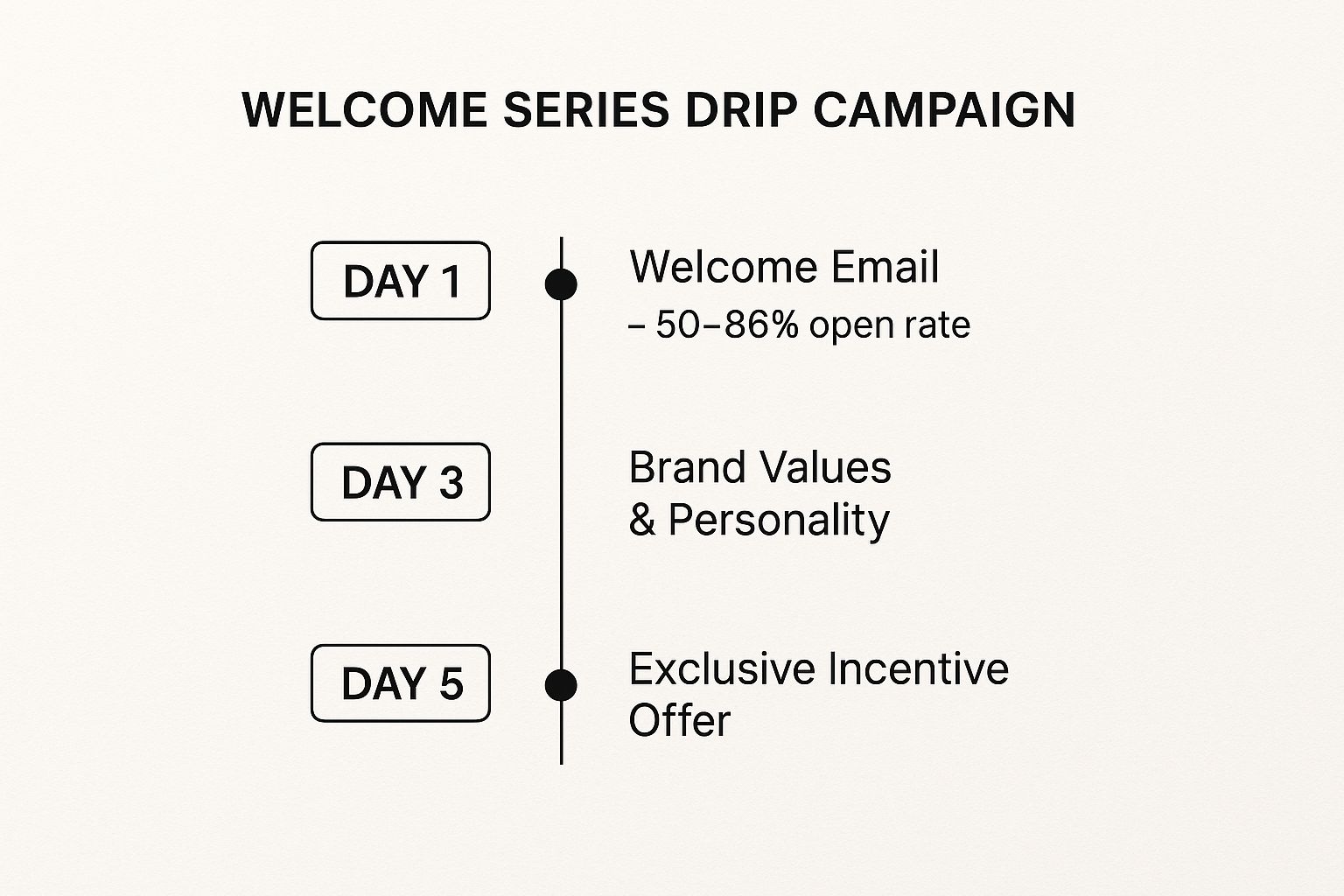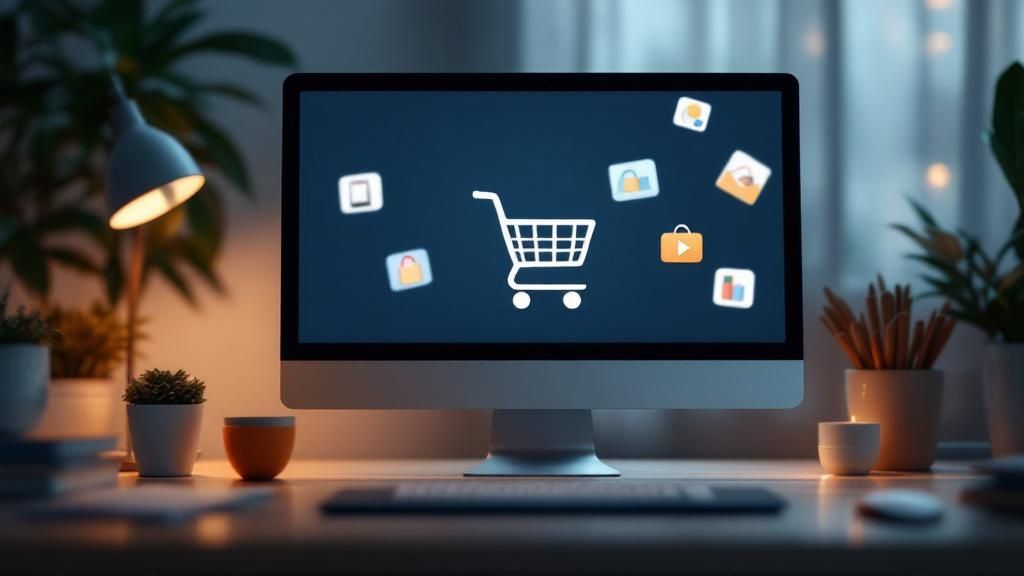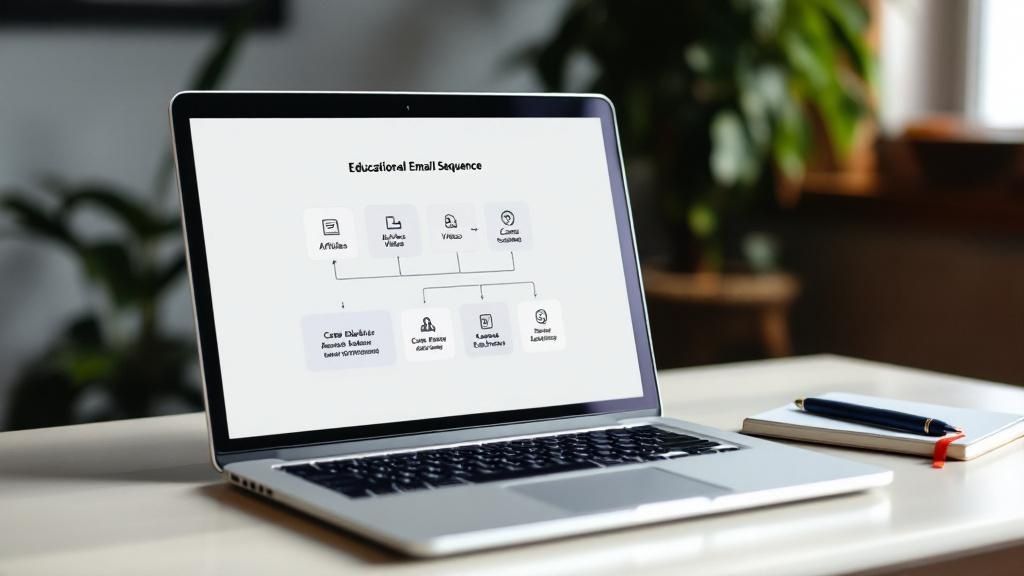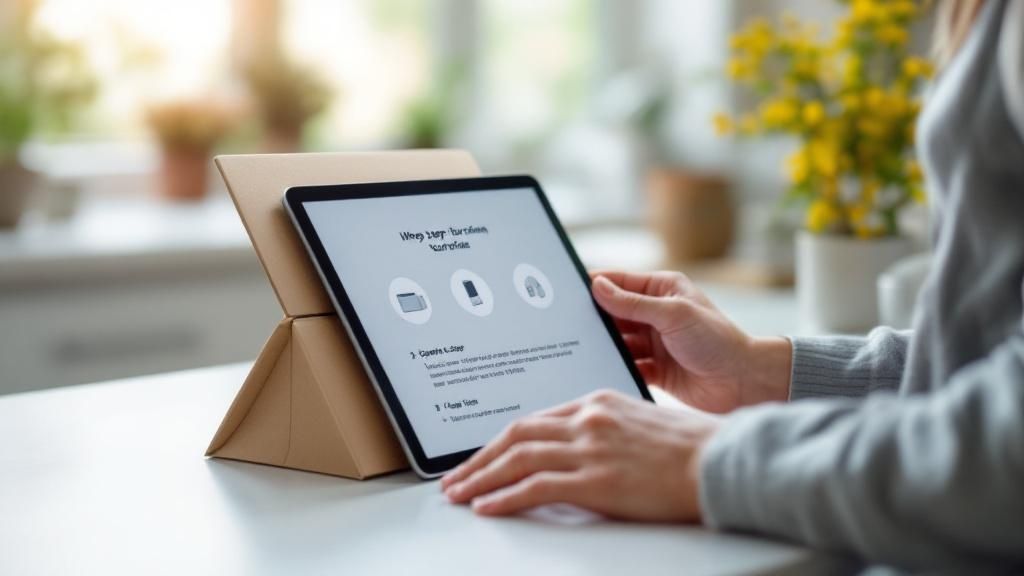In sales and marketing, timing isn't just important; it's everything. Sending the right message to the right person at precisely the right moment is the key to converting leads, onboarding customers, and driving sustainable growth. This is where drip campaigns become your most powerful tool. A drip campaign is an automated sequence of pre-written messages sent to specific segments of your audience over a set period, triggered by their actions or timeline milestones.
Instead of relying on manual, one-off communications, this automated approach ensures consistent, timely, and relevant engagement without constant oversight. It allows you to build relationships at scale, guide prospects through your sales funnel, and keep existing customers engaged long after the initial purchase. The core advantage is strategic precision: you can nurture leads with educational content, re-engage inactive users, or seamlessly onboard new clients, all while you focus on other critical business tasks.
This article moves beyond theory to provide a deep, strategic breakdown of high-impact drip campaign examples. We will dissect the exact tactics, timing, and copy that make these campaigns successful, offering actionable blueprints you can adapt for your own business. You'll see precisely how to structure a welcome series, recover abandoned carts, and execute a powerful re-engagement strategy. To dive deeper into various successful approaches, you can find more email drip campaign examples that showcase diverse strategies. Get ready to transform your outreach from a manual chore into a highly effective, automated growth engine.
1. Welcome Series Drip Campaign
The Welcome Series is arguably the most crucial of all drip campaign examples. It’s your first, and best, opportunity to make a strong impression on a new subscriber, lead, or customer. This automated sequence of emails is triggered immediately after someone signs up, making a purchase, or joining your community.
A well-executed welcome series does more than just say "hello." It confirms the subscription, sets expectations for future communications, introduces your brand's personality, and delivers immediate value. This initial interaction is critical; a positive first experience can significantly boost long-term engagement and conversions.
Strategic Breakdown
Companies like Slack and Airbnb have mastered the welcome drip campaign. Slack's onboarding sequence doesn't just welcome users; it actively teaches them how to use core features through a series of short, actionable emails. Each message focuses on a single benefit, like creating a channel or integrating an app, turning a passive sign-up into an active, engaged user.
Similarly, Airbnb’s welcome series is segmented for hosts and guests. A new host receives emails guiding them through listing optimization and calendar management, while a new guest gets travel inspiration and tips for booking their first stay. This segmentation ensures every user receives highly relevant content that addresses their specific needs and goals.
Key Insight: The primary goal of a welcome series is to guide a new contact from initial awareness to active engagement. It's not about a hard sell; it's about building trust and demonstrating value right from the start.
Actionable Takeaways
To build an effective welcome series, focus on a clear, progressive journey for the user.
- Immediate Delivery: Send the first email the moment a user signs up. This capitalizes on their peak interest and confirms their action was successful.
- Set Clear Expectations: In your first email, tell subscribers what kind of content they will receive and how often.
- Provide Value First: Before you ask for anything, give them something valuable. This could be a helpful guide, a free resource, a checklist, or an exclusive tip.
- Progressive Profiling: Use clicks and interactions within the welcome series to learn more about your subscribers. Ask a simple question or link to different content pillars to segment them for future, more personalized campaigns.
The following timeline visualizes a common structure for a welcome drip campaign, highlighting the key touchpoints and their intended impact over the first few days.

This visual progression shows how a welcome series strategically builds a relationship, moving from a high-engagement initial touchpoint to brand connection and, finally, a clear call to action.
2. Abandoned Cart Recovery Campaign
The Abandoned Cart Recovery campaign is one of the highest-impact drip campaign examples for any e-commerce business. This automated sequence is triggered when a user adds items to their online shopping cart but leaves the website without completing the purchase. Its primary goal is to re-engage these high-intent prospects and guide them back to finalize their transaction, recovering otherwise lost revenue.
A powerful abandoned cart series does more than just send a simple "You left something" reminder. It strategically addresses common purchase barriers like shipping costs or decision anxiety, uses social proof, and provides a gentle nudge, often with an incentive, to complete the purchase. This direct line of communication with a highly qualified lead is a critical tool for boosting conversion rates.

Strategic Breakdown
Companies like Casper and ASOS have turned cart recovery into an art form. Casper's emails don't just show the abandoned mattress; they address common hesitations by including customer testimonials, links to their generous return policy, and content about the benefits of a good night's sleep. This approach shifts the focus from a simple transaction to solving the customer's core problem.
Fashion retailer ASOS takes a visual and aspirational approach. Their recovery emails often showcase the abandoned items styled in different ways or suggest popular alternatives. By creating a sense of "style FOMO" (fear of missing out) and showing related products, they maintain the shopping momentum and provide more reasons for the customer to return and browse, even if their original item is no longer the main focus. This tactic is especially effective in B2C, though similar principles can be applied to some B2B sales lead generation strategies.
Key Insight: An effective abandoned cart campaign isn't just a reminder; it's a final opportunity to overcome friction. Focus on reassuring the customer, reinforcing the value of their chosen products, and making it as easy as possible to complete the checkout process.
Actionable Takeaways
To build a cart recovery sequence that converts, timing and content are everything. Your goal is to be helpful, not pushy.
- Act Quickly: Send the first reminder email within 1-3 hours of abandonment. This is when the purchase intent is still at its highest, and the user may have simply been distracted.
- Show, Don't Just Tell: Always include high-quality images of the items left in the cart. A visual reminder is far more powerful than text alone.
- Address Common Objections: Use your emails to proactively answer questions about shipping costs, return policies, or product guarantees. Including an FAQ link or customer support contact can build trust.
- Use Incentives Strategically: If a simple reminder doesn't work, consider offering a small incentive like free shipping or a 10% discount in a later email (e.g., 24-48 hours after abandonment). This can be the final nudge a price-sensitive customer needs.
- Create a Clear Path Back: Ensure your call-to-action (CTA) button links directly back to the pre-populated cart, making it frictionless for the user to complete their purchase in one click.
3. Lead Nurturing Educational Campaign
A Lead Nurturing Educational Campaign is a strategic sequence designed to build trust and authority with prospects who are not yet ready to buy. Instead of pushing a direct sale, this drip campaign focuses on providing consistent value by educating leads about industry challenges, solutions, and best practices. It’s a powerful tool for moving contacts from the top of the funnel to the middle and bottom stages.
This approach is essential because most new leads are not sales-ready. By delivering high-value educational content over time, you position your brand as a trusted expert and the go-to resource in your field. This type of campaign nurtures a relationship, ensuring that when the prospect is ready to make a purchasing decision, your brand is top of mind.

Strategic Breakdown
Companies like HubSpot and Moz have built their empires on the back of educational lead nurturing. HubSpot’s inbound marketing email series is a masterclass in this approach. When a user downloads an ebook, they are entered into a drip campaign that provides a stream of related blog posts, templates, and webinar invitations. Each email solves a small problem for the marketer, gradually introducing HubSpot’s software as the ultimate solution.
Similarly, Moz nurtures new sign-ups with its SEO Learning Center emails. Instead of a hard sell, they deliver tips on keyword research, link building, and site audits. This establishes Moz’s authority and builds a strong rapport with the audience. By the time a "soft CTA" for Moz Pro is introduced, the lead already understands the value and trusts the source, making the conversion much more likely.
Key Insight: The goal is not to sell, but to educate. By generously sharing your expertise, you build credibility and guide leads toward your solution organically, letting them arrive at the purchasing decision on their own terms.
Actionable Takeaways
To create a successful educational lead nurturing campaign, map out your content to your buyer's journey. Learn more about the core concepts with this guide to lead nurturing.
- Segment Your Audience: Don't send the same content to everyone. Segment leads by their role, industry, or the specific topic they showed interest in to ensure maximum relevance.
- Mix Content Formats: Keep your audience engaged by providing a variety of content types. Alternate between blog posts, case studies, video tutorials, webinar invites, and white papers.
- Use Lead Scoring: Track engagement (opens, clicks, downloads) to identify which leads are becoming more interested. A high lead score can trigger a notification for a sales rep to reach out personally.
- Incorporate Soft CTAs: While the primary goal is education, include low-commitment calls to action. Suggest they "read a related case study" or "register for a free webinar" instead of a "buy now" button.
4. Re-engagement Win-Back Campaign
The Re-engagement Win-Back Campaign is a critical tool for list hygiene and customer retention. This automated sequence targets subscribers or customers who have become inactive, meaning they haven't opened emails, clicked links, or made a purchase for a specific period. Instead of letting these contacts go cold, this campaign attempts to reignite their interest and bring them back into the fold.
A successful win-back campaign acknowledges the user's absence, reminds them of the value your brand offers, and provides a compelling reason to return. It’s a final, strategic effort to salvage a relationship before pruning the contact from your list, which ultimately improves your overall deliverability rates and engagement metrics. This is one of the most cost-effective drip campaign examples, as retaining an existing customer is far cheaper than acquiring a new one.
Strategic Breakdown
Subscription giants like Netflix and Spotify are masters of the win-back campaign. Netflix sends out iconic "We miss you" emails showcasing new, popular shows and movies tailored to a user's past viewing history. This isn't just a generic plea; it's a personalized reminder of the content they're missing out on, making the offer to return highly relevant.
Similarly, Grammarly's re-engagement emails focus on productivity and value. They often send a "writing stats" report summarizing how the user previously benefited from the tool, paired with an incentive to upgrade or start using the service again. This data-driven approach reminds users of the product's tangible benefits, effectively demonstrating what they stand to gain by re-engaging.
Key Insight: The core objective of a re-engagement campaign is to remind inactive users of the value they once found in your brand. Personalization is paramount; a generic message will likely be ignored, but a relevant offer or reminder can successfully reactivate a dormant user.
Actionable Takeaways
To build an effective win-back campaign, you must combine empathy with a strong value proposition.
- Define Inactivity Clearly: Establish a precise trigger, such as 90 or 180 days without an open, click, or purchase. This ensures you target the right segment at the right time.
- Craft a Standout Subject Line: Use curiosity-driven or direct subject lines like "Is this goodbye?" or "A special offer just for you" to cut through the inbox clutter and grab their attention.
- Offer Genuine Value: A simple "we miss you" is not enough. Provide a compelling reason to come back, such as an exclusive discount, early access to a new feature, or a helpful resource based on their past interests.
- Ask for Feedback: Include a simple one-click survey asking why they've been inactive. This not only shows you value their opinion but also provides crucial data to improve your overall marketing strategy.
5. Post-Purchase Onboarding Campaign
The sale is just the beginning of the customer relationship, not the end. A Post-Purchase Onboarding Campaign is a vital sequence designed to welcome new customers, guide them through product usage, and validate their decision. This drip campaign combats buyer's remorse and transforms a one-time transaction into long-term loyalty by ensuring customers achieve their desired outcome with your product.
A successful onboarding sequence is proactive, not reactive. It anticipates common questions, highlights key features, and demonstrates value quickly. By helping customers get set up and experience an early win, you dramatically increase product adoption, reduce churn, and build a foundation for future upselling and advocacy.
Strategic Breakdown
Companies like Notion and Peloton excel at post-purchase onboarding. When a user signs up for Notion, they don't receive a generic "thank you." Instead, they get a series of emails guiding them through setting up their first workspace, using templates, and collaborating with a team. Each email is a mini-tutorial, turning an empty dashboard into an indispensable productivity hub.
Peloton's approach focuses on community and motivation. After a purchase, new members receive emails introducing them to different trainers, types of classes, and community features like high-fives. This strategy shifts the focus from the physical bike to the engaging experience and supportive ecosystem, making the customer feel like part of an exclusive club from day one.
Key Insight: The goal of a post-purchase onboarding campaign is to bridge the gap between purchase and value. It should actively guide the customer to their "aha!" moment as quickly and smoothly as possible, cementing the product's place in their daily routine.
Actionable Takeaways
To create an effective post-purchase campaign, map out the ideal customer journey from initial login to proficient user.
- Start with Immediate Next Steps: The first email should arrive instantly, confirming the purchase and providing a clear, simple first action, like "Log In and Set Up Your Profile" or "Watch This 2-Minute Quickstart Video."
- Progressive Feature Disclosure: Don't overwhelm users with every feature at once. Introduce new capabilities sequentially, linking each feature to a specific benefit or outcome.
- Celebrate User Milestones: Automate emails that acknowledge achievements, such as "You've completed your first workout!" or "You just created your 10th note!" This positive reinforcement encourages continued engagement.
- Provide Clear Support Channels: Make it easy for customers to get help. Include links to your knowledge base, user community, or customer support team in every email.
The video below provides a deeper dive into crafting an onboarding experience that retains customers and turns them into advocates.
By systematically guiding your new customers, you not only improve their experience but also lay the groundwork for a profitable, long-term relationship. To explore this topic further, you can learn more about how a Post-Purchase Onboarding Campaign can boost customer success.
6. Birthday and Anniversary Campaign
The Birthday and Anniversary Campaign is a highly personalized type of drip campaign triggered by a specific date significant to the customer, such as their birthday, the anniversary of their first purchase, or their sign-up date. This automation leverages personal milestones to foster a stronger emotional connection, enhance brand loyalty, and drive repeat business through timely, celebratory offers.
These campaigns excel because they are inherently customer-centric. Instead of focusing on a product launch or a seasonal sale, the communication is centered entirely around the individual. This simple act of remembrance makes customers feel valued and seen, transforming a transactional relationship into a more personal one and making it a standout among drip campaign examples.

Strategic Breakdown
Companies like Starbucks and Sephora have turned birthday campaigns into a cornerstone of their loyalty programs. Starbucks Rewards members eagerly anticipate their annual free birthday drink, an offer that not only delights the customer but also drives foot traffic to their stores. The campaign is simple, automated, and highly effective at reinforcing brand loyalty.
Similarly, Sephora's Beauty Insider program offers members a free gift during their birthday month. This strategy creates a powerful incentive for customers to visit a store or make an online purchase. The campaign feels less like a marketing ploy and more like a genuine gift, strengthening the customer's relationship with the brand and encouraging them to explore new products.
Key Insight: The primary goal of a birthday or anniversary campaign is to celebrate the customer, not just to sell to them. The offer should feel like a genuine gift or an exclusive perk that acknowledges their loyalty and personal milestone.
Actionable Takeaways
To build an effective birthday and anniversary campaign, focus on making the customer feel special and appreciated.
- Collect Date Data Early: Integrate date collection (like birth dates) into your sign-up process or preference center. Frame it as a way to send them a special treat on their big day.
- Segment by Milestone: Don't just stop at birthdays. Celebrate the anniversary of a customer's first purchase or the day they joined your community to create more touchpoints for positive engagement.
- Make the Offer Exclusive: A generic 10% discount feels impersonal. Instead, offer a free gift, a high-value exclusive discount, or early access to a new product to make the celebration feel truly special.
- Personalize Beyond the Name: Use dynamic content to reference the specific milestone you're celebrating. For example, "Happy 2-Year Anniversary with us, [Name]!" is more impactful than a generic message.
7. Upsell and Cross-sell Campaign
An Upsell and Cross-sell Campaign is a powerful automated sequence designed to increase customer lifetime value (CLV). Instead of focusing on acquiring new customers, this drip campaign targets your existing customer base, encouraging them to purchase premium versions, add-ons, or complementary products based on their past behavior and purchase history.
These campaigns are highly effective because they engage an audience that already trusts your brand. By leveraging data on what a customer has already bought or used, you can present them with hyper-relevant offers that solve their next logical problem or enhance their current experience. This approach not only boosts revenue but also deepens customer loyalty by demonstrating that you understand their needs.
Strategic Breakdown
Companies like Amazon and Canva are masters of this type of drip campaign. Amazon’s recommendation engine is legendary, sending automated emails that showcase items "Frequently bought together" or "Inspired by your browsing history." These emails are triggered by purchase or browsing actions, making the cross-sell suggestions timely and contextually relevant.
Similarly, Canva targets its massive free user base with sophisticated upsell campaigns. After a user has created a certain number of designs or repeatedly tries to use a "Pro" feature, Canva triggers a drip sequence. These emails don't just ask for an upgrade; they highlight specific Pro features like the background remover or brand kit, directly connecting the premium offering to the user's recent actions and making the value proposition clear and compelling.
Key Insight: The most successful upsell and cross-sell campaigns are not about pushing more products. They are about providing logical next steps and enhanced solutions to a customer's existing challenges, making them feel understood and valued.
Actionable Takeaways
To build a high-converting upsell or cross-sell drip campaign, focus on timing, relevance, and value.
- Trigger Based on Behavior: Don't send generic offers. Trigger campaigns based on specific actions like product usage milestones, purchase of a specific item, or browsing a complementary product category.
- Focus on the "Why": Instead of listing features, explain the benefits. Show how the upgrade or additional product will save time, improve results, or unlock new capabilities for the customer.
- Incorporate Social Proof: Include testimonials or short case studies from customers who have benefited from the upgrade or complementary product. This builds confidence and validates the offer.
- Segment Your Customers: Create different campaign paths based on customer value or engagement level. A highly engaged power user should receive a different upsell offer than a less active customer.
7 Drip Campaign Types Comparison
| Campaign Type | Implementation Complexity 🔄 | Resource Requirements 💡 | Expected Outcomes 📊 | Ideal Use Cases 💡 | Key Advantages ⭐ |
|---|---|---|---|---|---|
| Welcome Series Drip Campaign | Medium – multi-email sequence, careful timing | Moderate – content creation, automation setup | High open rates (50-86%), strong first impression | New subscribers, brand introduction | High engagement, sets brand voice, immediate incentive |
| Abandoned Cart Recovery | Medium – triggered by behavior, integration needed | Moderate – tracking, product data, automation | Recovers 10-15% of lost sales, personalized reminders | E-commerce, abandoned carts | High ROI, targets warm leads, easy to scale |
| Lead Nurturing Educational | High – long timeline, diverse content | High – significant educational content needed | Builds trust, better quality leads over time | B2B SaaS, long sales cycle markets | Thought leadership, demand creation, longer LTV |
| Re-engagement Win-Back | Medium – behavior triggered, sensitive timing | Low to Moderate – content and automation | Low recovery (2-5%), list cleaning, insight into disengagement | Inactive subscribers, list hygiene | Improves deliverability, recovers dormant customers |
| Post-Purchase Onboarding | High – product-specific, detailed guidance | High – updated tutorials, support resources | Increases retention by 25-35%, reduces churn | New customers, product adoption | Boosts satisfaction, lowers support needs, expands revenue |
| Birthday & Anniversary | Low – date-triggered, personalized messaging | Low – data collection, simple automation | 2-5x higher engagement than promos | Relationship building, loyalty programs | High open rates, emotional connection, easy to automate |
| Upsell and Cross-sell | High – sophisticated segmentation, timing | Moderate to High – data-driven personalization | 5-25% higher conversion than cold campaigns | Existing customers, maximizing lifetime value | Increases revenue, improves customer satisfaction, lower acquisition cost |
Putting It All Together: Your Automated Growth Engine
Throughout this guide, we've dissected seven distinct and powerful drip campaign examples, moving far beyond theory into the practical mechanics of what makes them successful. From welcoming a new subscriber to re-engaging a dormant lead, each campaign serves a unique purpose, yet they all rely on a shared foundation of strategic automation, empathy, and value delivery.
The journey from a simple welcome email to a sophisticated, multi-touch re-engagement sequence can seem daunting. However, the core principles that drive results are consistent and replicable. By analyzing these diverse campaigns, from abandoned cart reminders to detailed post-purchase onboarding, we can distill a set of universal truths that form the blueprint for any high-performing automated outreach strategy.
Core Principles of Effective Drip Campaigns
Across all the successful drip campaign examples we've examined, four non-negotiable principles emerge. Mastering these is the key to transforming a basic sequence into a dynamic engine for building relationships and driving revenue.
- Segmentation is Non-Negotiable: A one-size-fits-all message resonates with no one. As seen in the lead nurturing and upsell campaigns, effective communication starts with understanding who you're talking to. Segment your audience based on behavior, demographics, purchase history, or engagement level to ensure every message feels relevant and personal.
- Timing is Everything: The power of a drip campaign lies in its timing. The abandoned cart sequence works because it triggers immediately. The re-engagement campaign is spaced out to avoid fatigue. Meticulously plan your delays and triggers to deliver your message at the precise moment it will have the most impact.
- Value Must Precede the Ask: Before you ask for a sale, a booking, or even a click, you must provide genuine value. The educational lead nurturing campaign is a prime example of this. By offering insights, resources, and solutions, you build trust and establish authority, making the eventual "ask" a natural and welcome next step.
- Personalization Goes Beyond
[First Name]: True personalization involves more than just mail-merge fields. It's about referencing past interactions, acknowledging specific user actions (like products they've viewed), and tailoring content to their known interests. The birthday and post-purchase campaigns demonstrate how this deeper level of personalization creates a memorable and loyalty-inspiring customer experience.
From Strategy to Execution: Powering Your Campaigns
Understanding these principles is the first step; executing them consistently and at scale is the next. Each of the drip campaign examples discussed relies on a robust technological foundation to manage the intricate logic of triggers, delays, and personalization. This is where a powerful multichannel outreach platform becomes indispensable.
This isn't just about sending emails. It's about creating a cohesive, automated ecosystem where every action a lead takes can trigger a tailored response. It's about having a centralized view of your outreach analytics to see what's working, what's not, and where to optimize. An automation engine is what turns your strategic blueprints into a living, breathing system that nurtures leads, closes deals, and retains customers 24/7, even while you focus on other critical business tasks.
Your next step is to bridge the gap between knowledge and action. Don't let the sheer volume of possibilities lead to inaction. Choose one campaign type from this article that addresses your most pressing business need right now. Is it converting more trial users? Re-engaging cold leads? Onboarding new clients more effectively?
Select your campaign, grab a pen and paper or open a new document, and map out the first three messages. What is the goal of each touchpoint? What value will you provide? What is the specific action you want the recipient to take? Taking this one concrete step will move you from passively learning to actively building your own automated growth engine.
Ready to turn these examples into your reality? Salesloop.io provides the powerful automation and multichannel outreach capabilities you need to build, launch, and optimize sophisticated drip campaigns with ease. Stop managing outreach manually and start building your automated growth engine by exploring Salesloop.io today.





